Altitude was not even a consideration when I first declared I was going to climb Mt Kilimanjaro as my chosen 50th year challenge. Aside from checking out some quick google searches and a whole bunch of awesome pictures, I had rather ignorantly and excitedly made a decision and announced to the World my plan based on pure desire. I love camping. I love hiking, I love nature. I had a huge desire to travel to Africa. I don’t even mind not showering for 7 days (on an adventure). It seemed like a match made in Heaven, except I just didn’t know yet if I actually enjoyed climbing mountains.
The phrase that really caught my attention and made me think this would not only be a cool experience but should be THE experience for me – “Mt Kilimanjaro is the highest point on Earth that is just a walk”. Perfect, I just have to be able to walk for 7 days straight … up and down a mountain. So off I go and buy every personal account book I can find on climbing Mt Kilimanjaro and begin my marathon reading blitz. The books quickly clued me into a challenge that had never crossed my mind; Altitude, Extreme Altitude.
I’ve been a skier most of my life and, despite living in Ontario where there are no real mountains, I’ve been lucky enough to have some travel ski trips to Tremblant, Alberta, St Annes etc. None were high enough for me to notice the affects of altitude, not even for this ‘sea level’ living chick. What I was learning about altitude and it’s affects was quite alarming and potentially life threatening and a complete crapshoot. Everything from Acute Mountain Sickness to Pulmonary Edema to Cerebral Edema. Scary stuff and it could all start affecting a climb around the 5000 to 8000 foot range. Climbing Mt Kilimanjaro requires someone to climb to the extreme altitude levels above 18,000 feet.
There is very little you can do to prepare for a 7 day high mountain experience when you live at sea level. Being in good shape might help your body adjust to altitude more easily but even athletes have issues with altitude. There is a drug named Diamox that may help but it comes with some pretty bad side affects that might take you down. So off to the Naturopath I go for her intelligence and research with supplements; Gingko, vitamin C and Coca leaves. Ultimately, the best way to train and learn how your body adapts is to go to high places and train.
A year into my lifestyle transformation, I decided I did not want to go to Africa without at least knowing how my body ‘might’ deal with altitude. There are not many fair weather mountains in Canada over 10,000 feet so we decided on Colorado as our ‘test run’ for Africa just 2 months prior to our big climb. Colorado contains the highest of the Rockies and has 53, 14,000+ foot mountains, referred to as ’14ers’. Denver is also a great base camp since the city is exactly 1 mile up (5280 feet).
Day 1 we spent touring the city to acclimatize. Day 2 we hired a guide with the goal of reaching a 10,000 foot summit. We were all mesmerized by the absolute beauty of Colorado. Trekking through the mountain forest and every once in a while having a great vista viewpoint was awesome. Around 8000 feet though, I started feeling nauseous and quietly moved myself to the back of the pack so I wouldn’t slow the others down. I could actually feel I was starting to walk like I’d had a few too many drinks. I was not stopping though, I was sure it would pass. At about 9200 feet, I actually fell off the path and was falling down the mountain face first into a rock, luckily that rock stopped me and I was able to get my arms in front of my face before I hit it. With all the sounds of nature in the mountains, my climbing team didn’t even hear me fall. Silly, but this made me happy since I did NOT want to stop. I climbed back up the hillside, brushed myself off and kept on trekking. When the party took a little break for water, they had me move to the front of the pack and noticed that the back of my arms and legs were covered in blood. Whoops, couldn’t see that! What happened? Why didn’t you say anything? We should descend.
In the mountains, your guide is THE BOSS. If they say descend, you listen. I wasn’t fully up on mountain etiquette at this point nor is my personality one to quit or give up. I managed to convince the guide I was okay and he let us continue on as long as I stayed in the front. Off I go, relieved and feeling like a mountaineer girl about to reach the first really high summit of her life … for about 10 more minutes. My head was pounding, I felt nauseous and could hardly keep a straight line despite my huge efforts. I had to confess I felt like crap. I felt completely deflated, like a bit of a loser and worried about my Africa challenge. My team were all fine, it was just me who couldn’t handle the altitude. Back to Denver we went and boy oh boy was it amazing how quickly I felt normal again as my body got more oxygen.
Day 3 we had a 4am wake up call. This was the big climb day. Today we would climb our first 14er, Mt Beirstadt at 14,065 feet. I felt good but, was worried based on issues the day before. That’s a lot of ascent in one day! It was such a beautiful day but the weather system on a mountain can change very quickly so our guide set a goal that we would be off the mountain by mid afternoon. To have the physical conditioning to climb for so many hours would be an accomplishment but I was truly hoping my body would bless me with some quick acclimating. Hours and hours and hours on end of slow trudging uphill. The trick is to take it slow, I’ve heard it referred to as “an arthritic 90 year old walking backwards is probably too fast”. Our hippy snowboarder guide and 15 yr old son were so far ahead at times we couldn’t see them. They would occasionally run back to check on us then skip forward even farther. Mountains do a funny thing to you. It will seem you are closing in on the Summit since all you see is a peak with endless sky yet when you get there you find out there’s not only another hump but another 2 or 3. Very much like an oasis in the desert, mountains play with your mind.
On most mountains the true tell you are approaching the Summit is large boulders at the top. After hours of climbing, we finally reach the boulders and for 2 hours we are climbing and scrambling 13,000+ feet in the sky. One wrong move could have some pretty bad consequences! At last, the ridges and humps and boulders finally end and we realize we are truly at the top of Mt Beirstad. The highest, by far, we have ever stood.
Our son had reached the summit earlier and we were excited to see his reaction. We found him sitting on a boulder with his head in his hands and no desire to check out the incredible view. He had altitude sickness from climbing way too fast and not giving his body time to adjust. The only cure for altitude sickness is to descend immediately so off he went while we captured some quick pictures and tried to embed the wonderful panorama of Colorado into our brains.
Elated! Grateful! 14,065 feet and I was totally fine. I actually felt wonderful! What a relief. Having problems the day before, descending to sleep and going back out again was all my body needed to adjust thankfully. My 1st real summit experience and I felt strong and healthy and able to enjoy the view from the top. Ecstatic! This 1st Summit euphoria would totally suck me in.
I am a huge believer in having a positive, goal oriented attitude but my mountain climbing endeavours have proven there can be a limit to your altitude. Sometimes it’s not your “Your attitude will determine your altitude” but how altitude can determine your attitude. I think having a ‘Reach for the Sky’ attitude can open doors you never considered walking through before but being smart about how you approach those doors is really what determines your altitude.
Hey guess what I found out in Colorado? That I REALLY love climbing mountains 🙂


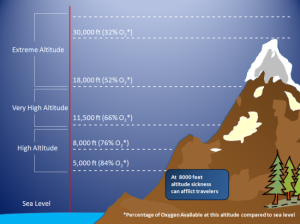
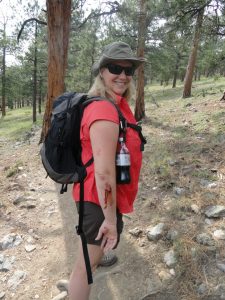
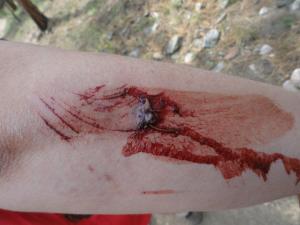
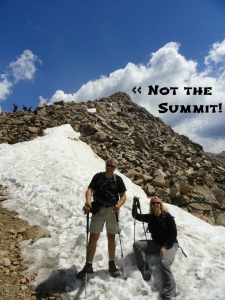
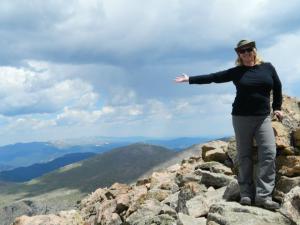
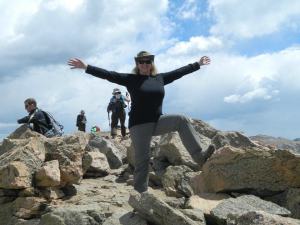
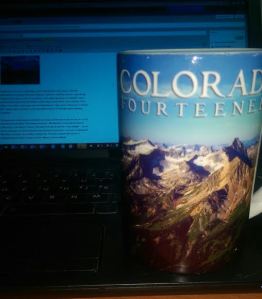
camperchristina
What a great post and what a great climb you did! congratulations on getting er done, once again, taking the bull by the horns and making it happen! I love this blog post, love the way you told the story, it was clear, easy to read but full of descriptive details that made me feel like I was climbing right there with you! Great photos as well! thanks for sharing this adventure with me! CHEERS LADY!
LikeLiked by 1 person
karengeterdone
Your support means a lot Christina! Thank you. So glad you’re enjoying the posts. I think I have one more in me before I leave on our next adventure. Definitely not going to be as prolific as you CamperChristina!
LikeLike
Jack Hammon d
When I went to climb Kilimanjaro I had severe bronchitis.and a sinus infection that gave me a bit of vertigo. I was about three hours from the summit coughing up a lung when my cockimbers and guide had a conference about whether I should go back down. It would have meant everyone went back. But it wasn’t altitude sickness. It was mostly a breathing management issue. I knew what altitude sickness felt like from climbing my Kenya. We made it
LikeLiked by 1 person
karengeterdone
Impressive Jack! Especially given the warnings on the sign before you start climbing Mt Kili .. spunky!
LikeLike
Mei Ling
Great recap Karen! I can’t believe you fell on your way up. I can believe that you talked your guide out of making you descend. 😉 I wish you’d written this post before I went to Peru. This post would have helped me out on what to expect at high altitudes. Can’t wait to read more!
LikeLiked by 1 person
karengeterdone
LOL guess high altitude doesn’t affect “spunk”. Really appreciate your feedback. I’m enjoying it, wish I’d started sooner.
LikeLike
Pingback: The Climb is the Reward – Mt Baker, Washington | karengeterdone
Pingback: Mt Kilimanjaro – Mountaineers in the Making | karengeterdone
Pingback: 5 Years of Challenges – karengeterdone